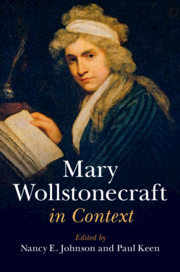Book contents
- Mary Wollstonecraft in Context
- Mary Wollstonecraft in Context
- Copyright page
- Contents
- Illustrations
- Notes on Contributors
- Preface
- Frontispiece
- Chronology
- Part I Life and Works
- Part II Critical Fortunes
- Part III Historical and Cultural Contexts
- The French Revolution Debate
- The Rights of Woman Debate
- Philosophical Frameworks
- Legal and Social Culture
- Chapter 23 The Constitution
- Chapter 24 Property Law
- Chapter 25 Domestic Law
- Chapter 26 Slavery and Abolition
- Chapter 27 The Bluestockings
- Chapter 28 Conduct Literature
- Chapter 29 Theories of Education
- Literature
- Suggested Further Reading
- Index
Chapter 26 - Slavery and Abolition
from Legal and Social Culture
Published online by Cambridge University Press: 16 January 2020
- Mary Wollstonecraft in Context
- Mary Wollstonecraft in Context
- Copyright page
- Contents
- Illustrations
- Notes on Contributors
- Preface
- Frontispiece
- Chronology
- Part I Life and Works
- Part II Critical Fortunes
- Part III Historical and Cultural Contexts
- The French Revolution Debate
- The Rights of Woman Debate
- Philosophical Frameworks
- Legal and Social Culture
- Chapter 23 The Constitution
- Chapter 24 Property Law
- Chapter 25 Domestic Law
- Chapter 26 Slavery and Abolition
- Chapter 27 The Bluestockings
- Chapter 28 Conduct Literature
- Chapter 29 Theories of Education
- Literature
- Suggested Further Reading
- Index
Summary
“I’d rather be a rebel than a slave” read the slogan emblazoned on the T-shirts worn by the cast of Suffragette (2015) during a promotional shoot for the magazine Time Out. The quote came from a speech given by Emmeline Pankhurst on July 14, 1913 at the London Pavilion; she went on to add “I would rather die than submit … my challenge to the Government is: ‘Kill me or give me my freedom.’” Pankhurst adopted the linguistic dichotomy of slavery and freedom to make a political point about the circumscription of what she perceived to be her inalienable right to full democratic citizenship. The reaction to the Time Out advertising campaign was swift and critical; Kirsten West Savali stated “When I see smiling white women effortlessly reject the label ‘slave,’ as if it solidifies their feminist credentials, I think about the daughter descendants of slaves … and my legacy of both rebel and slave, knowing that they are not mutually exclusive.” She argued that this instinct within Western feminism was “not a new tradition; it is time-honored and tested.”1 The incident underscored the complicated and uncomfortable relationship that feminism has sometimes shared with the history of race, class, and empire.
- Type
- Chapter
- Information
- Mary Wollstonecraft in Context , pp. 222 - 229Publisher: Cambridge University PressPrint publication year: 2020



